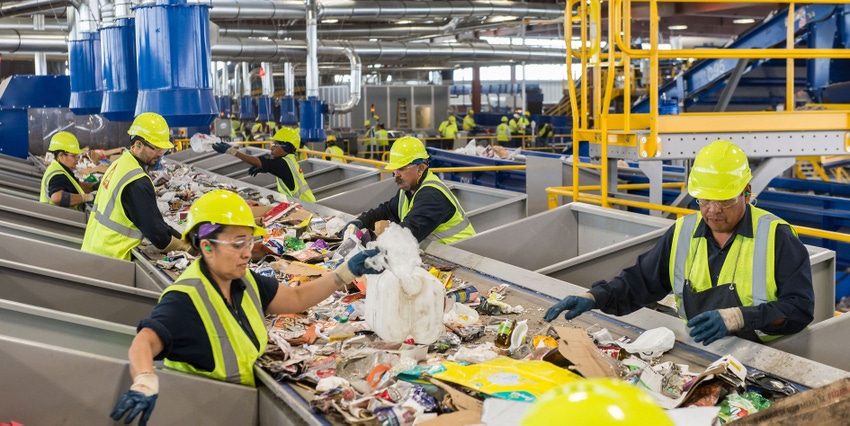Post-collections facilities include transfer stations, recycling centers and materials recovery facilities (MRFs).

Much is said and done in the industry to keep drivers and others safe during solid waste and recycling collection. From Slow Down to Get Around legislation (now in 13 states) and safe driver programs to on-board technology and new mechanized equipment over the years, a lot is being put in place to protect those collecting solid waste. Still, hazards remain. And for those involved in post-collections waste handling, education, planning and hyper-vigilance can be the difference in a safe working environment.
Post-collections facilities include transfer stations, recycling centers and materials recovery facilities (MRFs).
According to Jerry Peters, corporate Occupational Safety and Health Administration (OSHA) compliance manager for Rumpke Consolidated Cos., while transfer stations have their hazards, the risk is lowered by the fact that the amount of time drivers spend at those facilities is limited. The idea is to get in, transfer waste and get out. However, there is the potential for traffic injury, especially with heavy equipment and pedestrians.
“A 27,000-pound wheel loader versus a person is not going to end well,” says Peters.
Overcrowded driving areas can increase risk at these facilities, he says. Planning out proper employee walkways and overseeing a controlled environment is a must.
Peters and Jerry Sjogren, of E.L. Harvey & Sons, will speak at a WasteExpo session, Focusing on Post Collections Safety, on May 9th. The pair will focus on best safety practices, case studies and strategies aimed at making work safer for MRF, landfill and other post-collections employees. Waste Management Vice President of Safety Services Jeff Martin will moderate the session.
Safety practices are necessary at a transfer station, but they can be different from those of MRF employees, who tend to be hands on with the waste and potential for injury, he says, is greater. In December, the latest BLS fatality statistics showed the industry remains one of the most dangerous in the country. Additionally, BLS statistics in October showed the incidence rates of nonfatal occupational injuries and illnesses at MRFs in 2014 were 8.4 per 100,000 employees.
One potential danger is with syringes that end up in waste and recycling streams.
As more and more healthcare is being done in homes in the U.S. versus in a medical facility, more sharps and needles are being handled at home. Since these users are kept separate from hospitals, dentist and doctor’s offices, the rules for handling home sharps also are separate. In many instances, Peters says, people place their sharps in a rigid plastic container like a plastic laundry container. With automated solid waste systems, these containers can be smashed and open, leaving workers exposed to needles on sorting lines.
“The risk of needle sticks is still there,” Peters says.
Many MRF operators will tell you also about fire risk with cellphone and other lithium batteries, he says.
Lithium batteries, e-waste and hazardous materials incorrectly placed in recycling and trash loads are a big concern in post-collections safety as these can easily start fires in the right environments, putting workers in harm’s way. As equipment changes, so can the risks. Optical sorters in MRFs have 1,000-watt bulbs that can cause second- and third-degree burns, adds Peters.
But Rumpke has gone out of its way to focus on safety, investing big money in training and inviting fire safety personnel to train at their facilities so they know what to expect in the case of a fall or a fire.
The industry as a whole is improving on safety training and communications, says Peters.
The National Waste & Recycling Association (NWRA) offers training opportunities and awareness with programs such as Safety Mondays giving companies, large and small, ideas to up safety and lower risk for employees. Additionally, NWRA hosts three different Safety Stand Downs annually. Each week-long Safety Stand Down campaign focuses on a separate safety topic. NWRA provides participating companies throughout the industry with resources to distribute and use to train employees on safety topics.
Meanwhile, the Solid Waste Association of North America (SWANA) continues to highlight safety with its Safety Matters webpage, which is an online resource portal that includes information about each of SWANA’s safety initiatives—including the Safety Ambassador program, Slow Down to Get Around decal distribution, Safety Awards—and direct links to outside resources, such as OSHA and the Canadian Centre for Occupational Health and Safety (CCOHS).
“I know we’ve done a good job,” he says.
In fact, communication is improving amongst haulers industry wide. There was a time that when injuries and accidents happened in the industry, they were not discussed broadly. Today, many companies like Rumpke are talking to one another about what took place and what they did to fix the problem and how to prevent it from happening in the future.
About the Author(s)
You May Also Like


